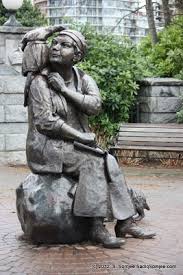
I found the bronze statue of Emily Carr, a Canadian icon, while I was on a cruise to Alaska. The trip was winding down and Victoria, British Columbia was the last excursion before disembarkation in Seattle. Keep in mind that I had just spent 13 days exploring the glorious Pacific Northwest frontier and the Alaskan glaciers as my backdrop. Breath-taking at every turn doesn’t adequately describe the magnitude of the scenery. So, why did a small bronze sculpture of an eccentric woman with a monkey on her back pique my interest?
First off, the statue is situated in the best spot along the harbor front; nestled in front of the Fairmont Empress Hotel, next to the BC legislative building. Jaw-dropping views of the deep blue sea and majestic Cascades mountains paint the backdrop. At night both the hotel and the government building light up like a twinkling cruise ship and a Disney castle, respectively. Before I go any farther, I need to tell you that Victoria is possibly the most gorgeous city in North America; it’s as if an offspring of a horticulturalist and a British architect designed the city with a mindset that it was best to err on the side of opulence. What did Emily Carr do to deserve a statue in such an aristocratic city, knowing full well that men are usually bestowed with ts honor?
Emily, 1871-1945, was Canada’s most recognized modern painter. Her complicated life took her to San Francisco, London, Cornwell and Paris where she refined her craft and cultivated her style. She painted portraits, still life, landscapes and flowers but is known as the earliest chronicler of life in BC, especially that of the indigenous people of the Pacific Northwest. Her achingly beautiful artwork followed a “God as Art” style.
A heart attack at a young age led her to pursue writing where she excelled in the genres of fiction and non-fiction. She even penned a ghost story. In her later years she became a devout animal activist. The monkey on her back, which is not often spotted at first glance, is Woo, her pet Japanese monkey. I like to think he represents her exotic talent; and although it took a toll on her life, she guarded it and kept it close to her heart. Emily was a feminist who had to fight many battles to gain acceptance into the art world. But like many women of merit, she persisted. Most Canadians consider her to be the darling of the women’s movement. The statue, by Canadian sculptor Barbara Paterson, was erected in Oct. 2016 as part of Women’s History Month.
Emily is a timeless treasure for any culture. I am glad she has been memorialized in bronze for the future. Long live the Queen of Canadian art!
Margaret says:
Thanks for including Emily Carr! I’ve read her story and was so impressed with her fortitude and determination, not to mention her artwork! I hope I have the opportunity to see her statue in person one day!
Pat Walters-Lowery says:
Wow. Who knew? Maybe people in Vancouver had heard of Emily Carr, but definitely not me. My next goal is to find out everything about her. Perhaps I can find pictures of her art work and copies of her writing. She sounds like a fascinating woman who never gave up.